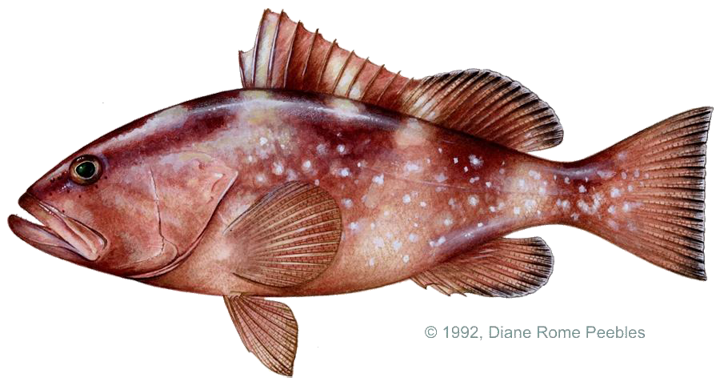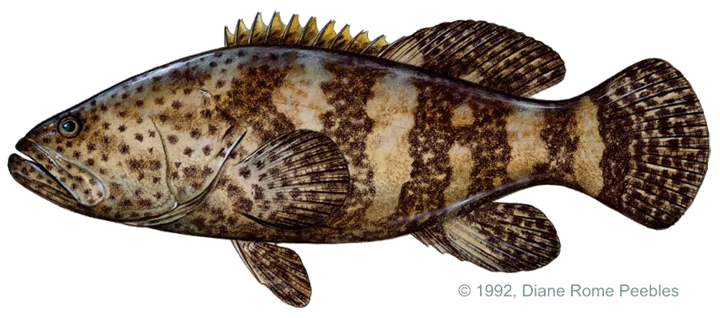Game Fish Identification Reference Guides
Grouper, red
(Epinephelus morio)
(Epinephelus morio)

(Valenciennes, 1828); SERRANIDAE FAMILY; also called garoupa-de-São Tomé, cherna Americana, cherna de vivero, mero paracamo, mero
This fish occurs in the western Atlantic from North Carolina to southern Brazil, including the Gulf of Mexico, Caribbean and Bermuda with strays occurring as far north as Massachusetts. Juveniles may be found in shallow water, but adults are mainly found resting in potholes on, or edges close to rocky, flat bottoms in depths up to 1000 ft (305 m). Red grouper rarely occur around coral reefs.
Color is variable and can change, however the head and body are generally dark brown with a reddish cast, shading to pink or reddish below, with pale poorly defined pale areas and small black spots around the eye. The lining of the mouth varies from scarlet to orange. The soft dorsal, caudal and anal fins are dark with narrow white edges. This species is distinguished from Nassau grouper by its lack of a black saddle spot on the top of the tail just behind the dorsal fin and its straight first dorsal fin.
Like other grouper, the red is usually caught while bottom fishing with cut or live bait. Unlike other grouper that are associated with reefs, reds can be taken on relatively light tackle. Red grouper is one of the most important species of fish caught off the coast of Florida, the Campeche Bank and Yucatan Peninsula.
While not as highly rated in food value as some others groupers, the red grouper is still considered fine table fare
This fish occurs in the western Atlantic from North Carolina to southern Brazil, including the Gulf of Mexico, Caribbean and Bermuda with strays occurring as far north as Massachusetts. Juveniles may be found in shallow water, but adults are mainly found resting in potholes on, or edges close to rocky, flat bottoms in depths up to 1000 ft (305 m). Red grouper rarely occur around coral reefs.
Color is variable and can change, however the head and body are generally dark brown with a reddish cast, shading to pink or reddish below, with pale poorly defined pale areas and small black spots around the eye. The lining of the mouth varies from scarlet to orange. The soft dorsal, caudal and anal fins are dark with narrow white edges. This species is distinguished from Nassau grouper by its lack of a black saddle spot on the top of the tail just behind the dorsal fin and its straight first dorsal fin.
Like other grouper, the red is usually caught while bottom fishing with cut or live bait. Unlike other grouper that are associated with reefs, reds can be taken on relatively light tackle. Red grouper is one of the most important species of fish caught off the coast of Florida, the Campeche Bank and Yucatan Peninsula.
While not as highly rated in food value as some others groupers, the red grouper is still considered fine table fare













